In order for your face to look exactly the way you dream after peeling, you must strictly follow the recommendations of cosmetologists. Exfoliation is always associated with a violation of the integrity of the skin to one degree or another. The cosmetologist must talk about what measures to take after this corrective procedure. However, not every woman, due to various circumstances, follows them. In this case, complications and side effects may occur.
In the epidermis injured by chemical or mechanical means, recovery processes are launched. How to restore skin after peeling? This procedure should occur naturally. Regeneration processes are launched in damaged skin. The main task of a woman in this case is to wait patiently. A cosmetologist will prescribe a product for restoring the epidermis, use it. Which product to use directly depends on the type of facial peeling and the characteristics of the woman’s skin.
How does peeling affect facial skin?
There are many types of exfoliation, but the principle is the same - disruption of epithelial tissue and stimulation of regenerative processes in the epidermis and dermis. This is how the physiological process of rejuvenation occurs. Our body is designed in such a way that it perceives injury after chemical peeling as an impulse to start the regeneration process. As a result, active formation of collagen fibers and hyaluronic acid molecules occurs. The epidermis is freed from dead cells of epithelial tissue, acquiring youth and elasticity.
Every woman should have a clear idea of what happens in her facial skin after peeling. The renewed epithelium forms new cells and tissues, and therefore requires special care. Even minor exposure to external factors can be dangerous for unformed epidermis. Therefore, any exogenous influence should either be excluded or minimized. Even your usual walks in the fresh air and familiar facial care products can worsen the condition of your skin after facial peeling, causing side effects. Therefore, cosmetologists and women with extensive experience in exfoliation recommend scheduling it at the end of the work week. Over the weekend, the skin will recover and by the beginning of next week the first positive results of exfoliation will be visible. Taking precautions, you need to follow the recommendations of specialists and after peeling, apply a cream that promotes rapid healing of the epidermis.
Even if you have undergone superficial facial exfoliation, which is gentle, you need to be careful. Dry and sensitive skin after exfoliation is especially susceptible to various environmental factors. If the cosmetologist did not focus your attention on post-peeling care, you should follow the general recommendations. You can learn in detail about how to care for your facial skin after peeling from our article.
How to restore skin after peeling?
There are a number of recommendations on how to restore skin after peeling. Their spectrum depends directly on the type and depth of exfoliation performed. The individual characteristics of the patient are also taken into account: skin type, age, tendency to allergic reactions, presence of chronic diseases.
If we consider the types of complications and side effects after exfoliation, we can name the following phenomena:
- Peeling is a normal consequence of the procedure. The feeling of dryness and tightness on the 3rd day transforms into detachment of epidermal particles, which spontaneously disappears after a maximum of a week. Natural products based on shea butter, jojoba, grape seed and with the addition of hyaluronic acid will help speed up the process;
- Hyperemia or redness is characteristic of rehabilitation after deep or median exfoliation. This side effect will go away in 5-20 days. The main thing during this period is to maintain a gentle diet, moderate physical activity and avoid stress. It is recommended to include foods rich in omega-3 acids in your diet;
- Swelling after exfoliation occurs in those with thin skin. On the recommendation of a cosmetologist, you can use a special facial gel after peeling with antioxidants that eliminates swelling;
- Inflammatory elements can result from incorrect exfoliation or improper post-peeling care. There are a number of spot-on products with antiseptic ingredients that will help in this case;
- Allergies can occur if an allergy test was not performed before the exfoliation procedure. If this reaction occurs, an antihistamine should be used;
- Increased pigment formation can be caused by improper preparation for exfoliation or exposure of the skin to sunlight after the procedure. Whitening creams and a diet that excludes foods that increase pigmentation will help cope with freckles or brown spots.
Each type of exfoliation has its own rehabilitation period. How to restore the skin after each of them?
Superficial
As you know, skin care after superficial peeling is the least troublesome. In this case, only the upper part of the epidermis is exfoliated. Just a couple of days after peeling, a film of young epidermal cells is formed. They require gentle care. After a superficial chemical peel, you should not use scrubs or roll off flaky and reddened epithelium for at least a week. Typically, a cosmetologist recommends using a cream that accelerates wound healing. After superficial peeling, skin care with panthenol-based ointments and creams is appropriate. This substance activates regeneration and prevents scar formation. It would be a good idea to drink an extra liter of water, which speeds up metabolic processes in the body.
Skin care after peeling with fruit acids and other types of gentle exfoliation involves the use of products that are gentle and contain a high sun protection factor. Apply them every time you go outside. When caring for your skin after peeling with acidic compounds, do not use alkaline, aggressive hygiene products that cause irritation to the epidermis.
Middle
Median exfoliation is a more serious effect on the skin with coral, trichloroacetic acids or a multi-acid composition. Therefore, after a mid-type chemical peel, a longer rehabilitation period follows. In this case, a woman may experience redness and peeling of the skin.
Many women are interested in the question: is it possible to cleanse the skin after peeling? The answer is clear: no! Do not use scrubs, roll or peel off scales with your hands. This leads to the formation of scars, which will be very difficult to remove! It is enough to wait a few days after the mid-peel without special care, and the peeling will go away on its own.
Skin care after chemical exposure should be very delicate. It is necessary to avoid both mechanical and chemical effects on the injured epidermis. As a facial cleanser, 3 days after peeling, you can wipe only with micellar water or another mild product without sulfates in the composition. You should also not use cosmetics, as you will need to remove makeup. Subsequent skin care after medium peeling is limited to the use of wound healing agents and the use of sunscreens.
Glubokoye
Deep exfoliation is a serious cosmetic and medical procedure and is performed under anesthesia. Phenolic, brown facial peeling, as well as laser resurfacing are effective methods for eliminating significant defects in the epidermis. But it should be understood that these types of exposure are highly traumatic.
Aftercare for this type of chemical peel can be done in a hospital setting, as the patient receives a controlled burn to the deep layers of the skin. Rehabilitation requires sterility and the use of medications: anabolic steroids, antibiotics and other drugs. This helps to cope with pain and prevents infection of the damaged dermis.
Care after the deep peeling procedure is special. For the first few days, you should not wash your face with water. After this, do not wipe your face with alcohol-based lotions. After deep peeling, part of skin care is the use of creams with a high UV protection factor. This mandatory requirement will help avoid the appearance of unwanted pigment spots.
Remember: washing your face during the rehabilitation process can be done with boiled warm water. The face should not be wiped, but blotted with a towel. Skin care after deep peeling can be carried out with products in the form of gel or foam. They do not need to be rubbed into the skin; they are easily absorbed.
Skin care after laser peeling and other deep effects is prescribed by a cosmetologist individually. Remedies for restoring serious damage to the epidermis usually include antioxidant substances: ubiquinone, tocopherol, selenium and other bioflavonoids.
Attention! The use of homemade masks during the rehabilitation stage must be agreed upon with a cosmetologist. Many components can trigger allergies, as skin sensitivity is increased.
General recommendations from cosmetologists
Typically, skin care after chemical peeling is discussed individually by a cosmetologist. It consists of many factors. The depth of exposure, the characteristics of the skin and the health of the patient are taken into account. However, there are general recommendations after facial peeling that can be called universal.
During the day after exfoliation, you cannot:
- Wash your face with soap, foam or gel;
- Touch, massage, rub, scratch the skin;
- Use moisturizing creams, nourishing serums, mattifying masks or lotions;
- Stay outside for a long time and come into contact with the sun's rays;
- Swim in the pool, take a steam bath, engage in active sports;
- Visit the solarium.
The next three days after exfoliation it is recommended:
- Wash your face with water with a slightly acidic pH or using a hypoallergenic, lightweight cleanser;
- Apply cream after peeling for the face with a wound healing effect. They usually contain panthenol or lanolin;
- Limit going outside, especially in sunny weather;
- Use products with a UV filter (SPF index - at least 35);
- Protect the skin from negative external factors: frost, wind, dust, sun.
For two weeks after exfoliation, you should adhere to the following recommendations:
- Use medications and creams prescribed by a cosmetologist;
- Refrain from using decorative cosmetics that clog pores;
- Do not remove scales, crusts, or scabs with your hands;
- Do not use scrubs, even the most delicate ones;
- Do not sunbathe in a solarium or in the sun, use sunscreen;
- Do not experiment with new brands of care cosmetics;
- Do not visit public baths, swimming pools, or open water bodies.
You've probably heard a lot of advice from friends and acquaintances on how to care for your face after chemical peeling, but you should only follow the recommendations of experienced cosmetologists. They will protect you from negative consequences in the form of complications and side effects.
How to deal with complications?
Unfortunately, exfoliation can bring not only smooth, glowing skin, but also scarring, acne, hyperpigmentation, and worsened cold sores.
Pigmentation is a rather unpleasant side effect of laser exfoliation and TCA. To prevent this, treat your face with kojic and retinoic acids before exfoliation. Some post-peeling treatments also remove subsequent pigmentation. This is the application of acetylcysteine and strong antioxidants (tocopherol, ascorbic acid, silene, etc.) to the epidermis.
Exacerbation of herpes may occur in those individuals who note this phenomenon at least twice a year. To prevent foci of herpes from spreading across the face after scrubbing or peeling the face, it is necessary to carry out appropriate therapy: take antiviral medications: oral medications and ointments.
If a woman is prone to acne, after exfoliation it may appear in an aggravated form. Agents with anti-inflammatory and sebostatic properties will be required. Antiseptic preparations with zinc can be applied pointwise to pimples and blackheads.
Severe peeling of the skin can also be observed after medium or deep exfoliation. There is no need to take any measures, the skin should exfoliate on its own. How to exfoliate skin faster after peeling? Cosmetologists strongly recommend: do not comb, do not pick off scales and do not use scrubs. All these manipulations can lead to scar formation.
How to prevent side effects?
In fact, if exfoliation was performed by a qualified cosmetologist taking into account the client’s characteristics, high-quality reagents were used, and aseptic conditions were observed, then there should be no adverse reactions, and negative consequences are excluded. But a lot depends on whether the woman follows all the recommendations she received from the specialist.
How to care for your facial skin after peeling at home?
The most important thing is to allow the epidermis to recover and not interfere with the natural regeneration process. After peeling, the skin of the face will begin to tighten, dryness will appear, and then peeling. These phenomena are natural and natural; there is no need to panic. Under no circumstances should you use a scrub after peeling your face. The injured epithelium will react to this action with scars and cicatrices, which are very difficult to remove.
The main thing in rehabilitation is gentle care. Can I wash my face after peeling? After deep and medium exposure, you should not wash your face with water on the first day. Over the next few days, you can only wash with boiled water. Then, for several weeks, it is recommended to use soft cleansers with a gentle hypoallergenic composition.
If a cosmetologist has prescribed medications (antibiotics, anabolic steroids, wound-healing ointments), they cannot be ignored. This can lead to irreparable consequences. The effect of exfoliation depends not only on the professionalism of the cosmetologist, but also on the responsibility of the woman herself.
What is not forbidden to do after peeling?
Repeatedly in this article it was stated what is prohibited to do after peeling. This means injuring the epidermis, staying in the sun and using any cosmetics.
Important! Despite the standard set of warnings from a cosmetologist, women are often concerned about the question: is it possible to wet their face after peeling? After deep and medium exfoliation, do not wet your face for 24 hours. Then you can wash only with boiled warm water.
A woman should understand that after a chemical peel, the quality of the result obtained largely depends on her actions. It is necessary to strictly follow the recommendations and exclude amateur activities. Only a professional can adequately assess the need or danger of even the safest procedure in your opinion. For example, after chemical exfoliation, you should not massage your face or even touch it. The sensitivity of the damaged epidermis is high, it can be easily harmed.
The cosmetologist recommends how to care for the skin after peeling so that the epidermis is restored without scars and blemishes immediately after the procedure. In addition to a number of standard manipulations, the beauty salon master will share with you special secrets of maintaining the peeling effect and prescribe a suitable line of products for post-peeling care. But keep in mind that you can use cleansers after facial peeling only after 3-4 days.
The rehabilitation period, depending on the depth of exfoliation, can last up to 3 weeks. In this case, you need to use cosmetics with extreme caution. The main thing is to avoid irritation, allergies, and clogged pores. When the epidermis is completely restored, you will again be able to use your favorite decorative cosmetics.
Summary
Proper care after peeling guarantees a woman a good result from the procedure and protects her from complications. Adverse reactions arise not only through the fault of the cosmetologist, but also from how the rehabilitation period goes. It is necessary to strictly follow all the recommendations of the salon master, use all prescribed products and medications and avoid amateur activities. Then exfoliation will be very effective, and the risks of complications will be reduced to zero. Skin glowing with beauty and youth will be a reward for your patience.
Will my skin peel after peeling? And if so, for how long? Such questions concern everyone who has decided to undergo this procedure and wants to understand whether it is possible to speed up the recovery process.
- Why does facial skin peel after peeling?
- Typical and atypical consequences of peeling
- How to remove peeling after peeling
- Review of anti-flaking products
Why does facial skin peel after peeling?
“It is important to understand: exfoliation of the skin (not to be confused with peeling) is the essence of the peeling procedure. The composition applied to the skin affects the connections between the cells of the stratum corneum of the epidermis. After some time, they peel off, which leads to accelerated division and renewal of cells in deeper layers. But sometimes the skin literally peels off in flakes, and sometimes it doesn’t.”
Several factors influence whether your skin will peel.
Intensity of the procedure
Superficial peeling removes dead cells of the stratum corneum and, depending on the concentration of the substance in the composition and the pH level, can cause intense peeling. Medium and deep peeling, affecting the deep layers of the epidermis, Always accompanied by peeling, redness, swelling.
Active substance
Alpha hydroxy acids, such as glycolic, apple, milk, pyruvic, are among the most gentle.
Trichloroacetic acid, which is most often used for medium peels, acts quite aggressively.
Enzyme peeling (active ingredients - bromelain, papain) rarely causes visible peeling.
Enzyme, or enzyme, peeling is the least likely to injure the skin, but does not provide such a powerful renewal effect as acid peeling.
© Getty Images
Individual skin characteristics
Sensitive, reactive, very dry skin can respond with peeling to even the most gentle composition.
Proper preparation
Well-moisturized skin, rich in nutrients, comes to its senses faster. So start preparing for your peeling session early.
Post-peeling care
mild cleanser;
alcohol-free tonic with a calming effect;
restoring cream or gel;
maximum sun protection.
Careful preparation for peeling, increased skin hydration, as well as gentle care after the procedure will help enhance its effect and avoid unpleasant consequences. © Getty Images
Typical and atypical consequences of peeling
These phenomena after peeling should not be a cause for panic:
redness (erythema) of the skin; occurs in the first minutes after the procedure; with superficial peeling it lasts 1–2 days, with medium peeling it lasts up to 5 days;
edema (starts 2–3 days after the procedure); lasts 2–3 days;
peeling (starts on days 2–3); with superficial peeling it lasts 2–3 days, with medium peeling it lasts up to 5–10 days.
Here is a list of atypical manifestations of peeling:
rashes in the form of acne - as a rule, are the result of improper care;
crusts and scars - formed when scales are torn off;
In all these cases, you must consult a doctor!
Sometimes after peeling, a thick crust forms on the skin that does not want to peel off. A cosmetologist also has special methods for this case.
How to remove peeling after peeling
Cleanse your skin properly. The ideal option is gentle cleansing, after which you can use drying lotions and tonics. Put gommages and scrubs aside.
Use intensive moisturizing and regenerating products with vitamins and antioxidants, hyaluronic acid, glycerin, urea, vitamins E and B3.
For severe itching and flaking, soothing and healing products based on panthenol and bisabolol will help. They are used for at least 3 days after the procedure.
If the peeling is alarmingly severe, consult a doctor. It will help remove flakes, reduce irritation and redness. Typically, in this case, enzymatic peeling based on whey is used. Plus, suitable cosmetic preparations are prescribed to speed up skin restoration.
In some situations, they even perform additional peeling with enzymes or lactic acid to facilitate the exfoliation process. © Getty Images
Under no circumstances should you:
peel off the scales - they must fall off on their own, otherwise scars may appear;
touching your face frequently, especially with dirty hands, can cause an infection;
apply decorative cosmetics to irritated skin;
go out in the sun without a strong sunscreen with SPF 50+;
visit a bathhouse or solarium;
contact with chlorinated hard water (in a swimming pool).
Review of anti-flaking products
Cream care for protecting very dry skin Nutrilogie 2, Vichy restores its own lipids, removes the feeling of tightness and evens out the relief. Jojoba and apricot oils, glycerin, arginine, vitamin E provide nutrition.
Soothing multi-regenerating balm Cicaplast Baume B5, La Roche-Posay makes the skin tender and soft, removes irritation and peeling. Panthenol and shea butter soothe. The plant component madecassoside accelerates recovery. A complex of copper, manganese and zinc has antibacterial properties.
Intense moisturizing regenerating gel Hydrating B5 Gel, SkinCeuticals with a high content of hyaluronic acid, as well as a component of natural moisturizing factor and vitamin B5 - excellent help after peeling. 4-5 drops in the morning and evening are enough for the skin to come to its senses faster and stop itching and flaking.
Moisturizing balm for dry and very dry skin Ultra Facial Deep Moisture Balm, Kiehl’s guarantees comfort, hydration and smoothness. Edelweiss extract strengthens the skin's own defenses. Antarcticin promotes its restoration. Glycerin retains moisture and soothes.
Cream 48 hours of nutrition and hydration for dry skin Aquasource Nutrition, Biotherm reduces tightness, restores the protective barrier and moisturizes the skin. Shea butter is responsible for lipid saturation.
Exfoliation is important for the skin for many reasons. Regular removal of the top layer of the epidermis prolongs the youth of the skin, improves its texture, and eliminates wrinkles, pimples and age spots. After peeling, the dermis better absorbs the beneficial substances included in skincare products. For the greatest effectiveness, you need to carry out the procedure according to all the rules, strictly maintaining the interval between sessions and choosing products that are suitable for the type and condition of the epidermis. Find out how peeling for dry skin is carried out in the salon, and what you can use for this purpose at home.
Characteristics of skin types
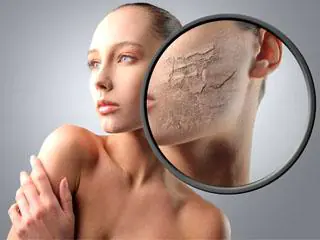
The skin has different thickness and texture. Depending on this, experts distinguish 5 types of dermis: dry, normal, sensitive, oily and combination (mixed).
Each of them is characterized by its own characteristics, which cannot always be determined visually, by eye. However, without this it is difficult to choose the right skin care.
To determine the type of epidermis, you can contact a cosmetologist or use a simple method: 2 hours after washing, blot your face with a paper napkin. There will be marks on it if your skin is oily (over the entire surface) or combination (marks only in the T-zone). Their description will help you understand the difference between other types of dermis:
- Normal. In this case, a person does not experience discomfort after water procedures (for example, there is no feeling of tightness). The skin is even, smooth, elastic, with a uniform color and without blackheads, the pores on it are not enlarged. With proper care, aging of normal dermis occurs after 35 years. But there are very few such lucky ones. Other types of skin are much more common.
- Dry. This type is the most difficult to self-diagnose. In youth, the dry epidermis has a matte texture and an even tone. It feels thin and not quite elastic, without shine and pronounced pores (the forehead and nose may be an exception). Owners of this skin type are familiar with the feeling of tightness after washing and flaking. The sebaceous glands, which sluggishly produce sebaceous secretions, are to blame for this. The first wrinkles will not keep you waiting if the dry skin is not provided with regular, competent care in a timely manner.
- Sensitive. It can be dry and oily, but regardless of this, it reacts painfully to heat or severe frost, many cosmetics and even improper care. May become covered with spots and rashes. Such dermis needs special, hypoallergenic cosmetics and careful selection of procedures in the salon.
By the way. Oily and combination skin types also have their disadvantages and advantages. As a rule, in these cases, peelings are used that control the functioning of the sebaceous glands, mattify the face and fight acne.
Indications for use
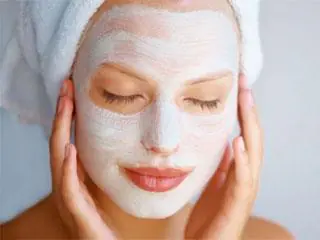
There is an opinion that dry skin does not need peeling. However, this is not quite true. The outer layer of dead cells of the epidermis does not allow nourishing and moisturizing components to penetrate into the deeper layers.
Peeling removes dead skin cells, freeing healthy tissue, activates blood circulation and enhances the effectiveness of skincare products.
Dry skin needs exfoliation just as much as other types of epidermis. But not all drugs can be used for this purpose. Cosmetologists advise choosing the most soft and delicate products, which will not injure the dermis and will allow you to get rid of the following problems:
- uneven complexion;
- sagging skin;
- small wrinkles;
- lightening of pigment spots, etc.
For dry skin, delicate glycolic or milk formulations are usually chosen. It is desirable that the concentration of acids be minimal. The frequency of procedures is 2-3 per month, unless the cosmetologist advises otherwise. In just a few sessions, it will be possible to rid the skin of peeling, make it uniform, smooth, more elastic, and brighten up the signs of aging.
Due to the risk of pigmentation, peelings are carried out in autumn and winter.
Pre-peeling preparation

Since peelings for dry skin do not involve radical cleaning of the top layer, the preparatory procedures in this case are minimal. You will need:
- Do not touch your face for at least a week: do not clean blackheads, do not do mesotherapy, etc.;
- after removing makeup, moisturize the skin with glycolic acid cream;
- stop taking certain medications and alcohol;
- do not sunbathe, do not visit the solarium and the beach.
Typically, these measures are relevant before carrying out salon peelings and using professional preparations at home. Before the procedure, be sure to visit a cosmetologist. The specialist will tell you which medications should not be taken. If you exfoliate with a mixture you prepare yourself, you won’t need any serious preparation.
Carrying out at home
Peels recommended for home use are less effective, but safer than salon peels. You can try different formulations and home recipes, but at the same time record how the skin reacts to them. She doesn't need additional dryness and irritation. Therefore, try to choose products without hard abrasive particles and with moisturizing ingredients - peelings and gommages.
Store-bought drugs
The most popular products for home use:
- Hyaluronic peeling roller Aquanti from the Novosvit company. Recommended for all types of dermis, including dry ones, as it moisturizes it due to the content of hyaluronic acid. Restores the water-lipid balance of the epidermis and does not cause a feeling of tightness. Evens out skin texture, exfoliates, heals and softens the skin. Other components in this peeling include collagen, apple, kiwi, grapefruit and orange extracts. The product has a delicate texture. Apply to dry, pre-cleansed dermis with movements reminiscent of a light massage. The exceptions are the areas around the eyes and lips. After the lumps roll off, the peeling is washed off with water. At the end of the procedure, you can use a moisturizer. You can buy a 100-ml bottle at a price of 100 to 200 rubles.
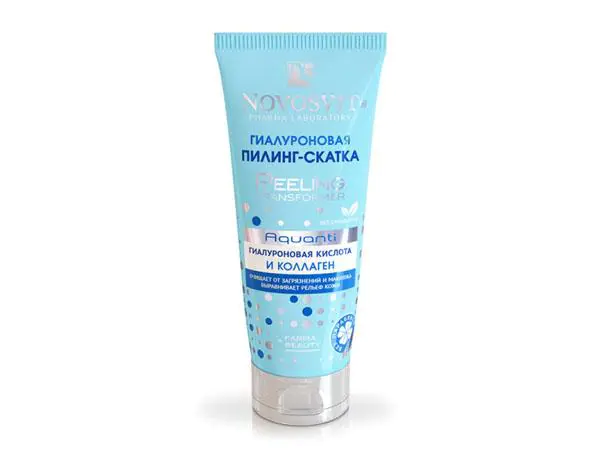
- Gentle peeling from Natura Siberica called Instant Skin Renewal. In parallel with exfoliation of the dermis, it enhances its protective capabilities. Makes the epidermis smoother and its shade more even. The product is designed for women with dry and normal skin types. AHA acids, meadowsweet, Manchurian aralia and other components are responsible for tone, firmness, elasticity and renewal of the skin. Peeling is a Natural&Organic certified product. It is easy to use: massage a damp face with a small amount of product squeezed out of a 150 ml tube. After this, the drug must be washed off. The cost of an organic product is from 180 to 300 rubles.
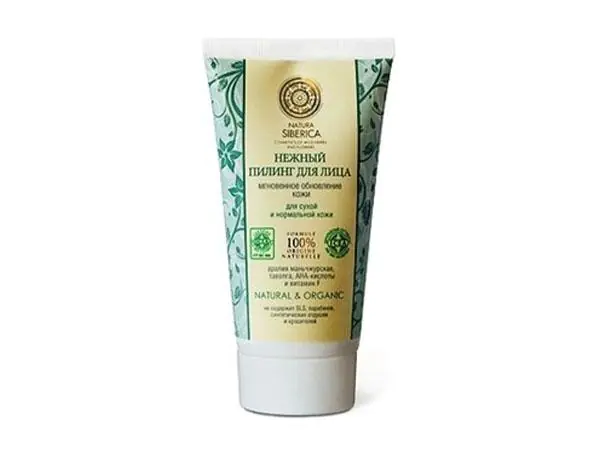
- RulerALPHA-BETA Israeli company Holy Land consists of several professional peelings, and also includes preparations that can be used at home. They contain various acids and retinol. For example, PREPPING LOTION peeling lotion additionally contains extracts of orange, lemon, green tea and other components. Evens out the texture and shade of the dermis and has a slight lifting effect. You need to wipe your face, neck and décolleté with lotion 2-3 times a week. A 250 ml bottle costs about 3,000 rubles. The line also includes RESTORING SOAP peeling soap, which maintains the water balance of the dermis, makes the skin smoother and more uniform, and reduces pores. In addition to the main ingredients (acids and retinol), it contains extracts of chamomile, maple, and horsetail. Available in liquid form, bottle volume - 125 ml, cost - about 1500 rubles. Directions for use: spread over damp skin, massage with light circular movements, rinse. The manufacturer assures that the product can be used daily.
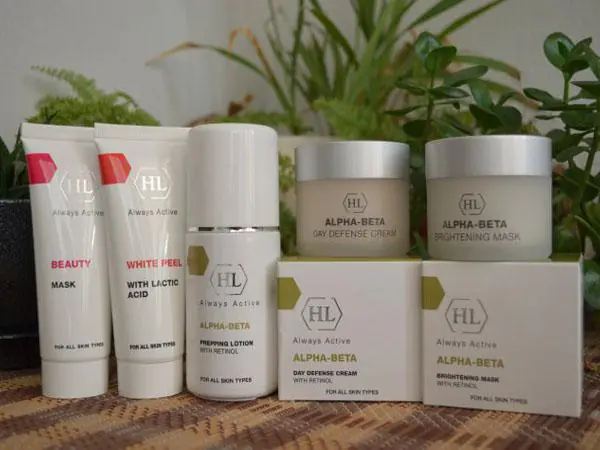
- Achromin, renewing peeling with AHA acids for dry and sensitive skin. Suitable for face, neck, décolleté. Refreshes and improves the skin, smoothing out unevenness. Contains glycolic, lactic and citric acids, as well as softening and moisturizing components - allantoin and panthenol, which promote the regeneration of the epidermis. Peeling can be used no more than 2 times a week, preferably in the evening. There are no age restrictions. Price: 350–570 rubles per 50 ml jar. The product is distributed over previously cleansed skin, taking into account the massage lines. An exception should be the area around the eyes. After 5–10 minutes, the peeling is washed off with warm water using a cotton pad, the face is blotted with a towel and a moisturizer is applied.
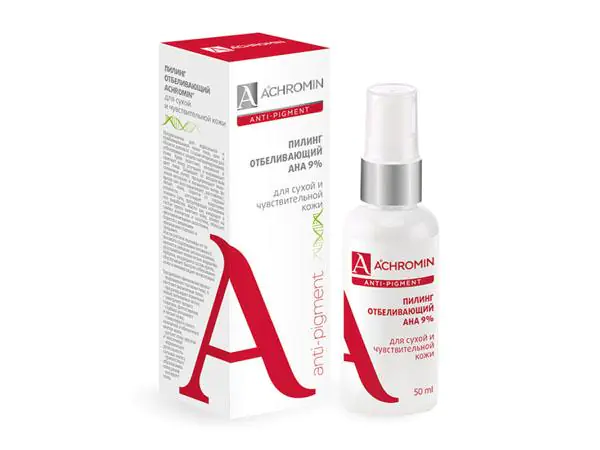
- Soft facial scrub Clean Line. Contains raspberry juice and cranberry seeds. Suitable for dry and sensitive skin. Gently removes dead cells of the dermis, improves complexion, tones and accelerates skin renewal. The scrub is applied to the neck and face, after moisturizing them. The area around the eyes does not need to be treated. After a light massage, the product is washed off with warm water. A 50 ml tube costs about 70 rubles.
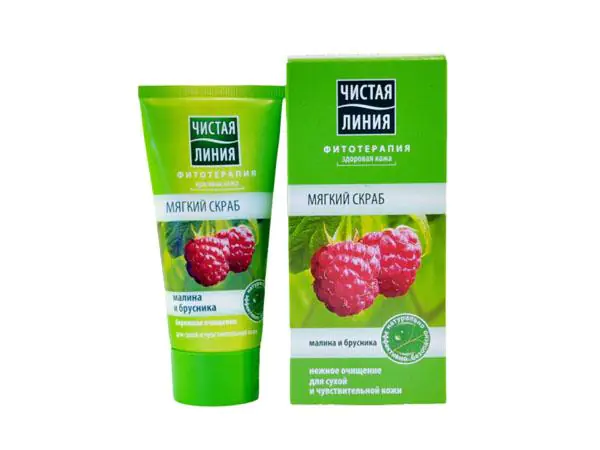
Attention! When doing the procedure at home, many women use professional products designed for experienced and competent cosmetologists. For example, Lingonberry Peeling from NEW LINE PROFESSIONAL. However, consider whether such amateur activity is justified, as it increases the risk of complications and side effects.
Folk remedies
These peels for dry skin are the safest and most gentle. After all, they contain fruits, berries, vegetables, cereals, and dairy products. Here are some popular options for at-home exfoliators:
- Oatmeal peeling. The flakes can be combined with fresh cucumber gruel, carrot juice, olive and castor oils. One of the simple recipes is oatmeal with milk. 2 tbsp. l. flour or crushed cereal, pour in the same amount of heavy cream. You can replace them with yogurt. Let the mixture sit for 10 minutes.
- Strawberry peeling. Wash and remove stems from 3-4 large ripe berries, pour in 2 tbsp. l. fat milk or sour cream, stir until it becomes a thick paste.
- Honey. In winter, such peeling will also have a local immunostimulating effect. For this recipe, 1 tbsp. l. liquid honey is combined with 1 tsp. cream, 0.5 tsp. semolina (cereals). Add 1 tsp there. banana pulp and grated apple. After 3 minutes, when the semolina swells, the mixture becomes ready for use.
- Egg-honey-oat peeling. You need to take 1 tbsp. l. liquid honey and oatmeal, combine these ingredients. The yolk of a chicken egg, separated from the white, should be beaten in a separate container and then added to the honey mixture.
- Coffee and milk. Mix equal parts of the coffee grounds with full-fat milk or cream. You can also apply coffee liquid to your face. Just keep in mind that the grains must be ground very finely. Even in this case, small particles will still remain hard, so on dry skin this product should be used no more than once every 2 weeks.
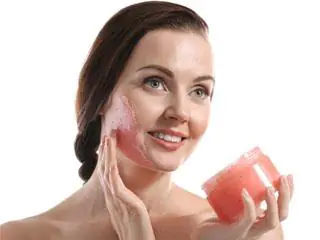
Home peelings are done according to the same scheme:
- Cleanse the face of cosmetics and dust using soap and foam.
- For 2–3 minutes, distribute the freshly prepared composition over the skin, moving along the massage lines.
- After 10 minutes, wash off the peeling with warm, then cold water.
- Apply a nourishing mask. Optimally - oil (store-bought or homemade).
- After washing it off, if necessary, moisturize the face with cream.
Advice. Alternate mixtures for peeling so as not to cause your skin to become addicted to the same components.
Salon treatments
For patients with dry skin, cosmetologists can recommend the following types of peelings:
- Surface chemical. It will help even out the texture and tone of the skin, eliminate minor pigment spots, and smooth out fine wrinkles. The course of procedures consists of 4–6 sessions every 2 weeks. During peeling, the cosmetologist treats the skin with preparations containing acids in low concentrations (glycolic, lactic, sometimes mandelic or others). The rehabilitation period lasts about 7–10 days. As a rule, after such peeling the skin does not become very red or crusty.
- Enzymatic. Other names are enzymatic or enzymatic. This peeling is suitable even for sensitive skin with rosacea. The active ingredients are not acids, but enzymes (papain, ficin, etc.). They cleanse the epidermis of impurities and polish it. Enzyme peeling fights inflammation and increased pigmentation. Due to its gentle effect on the skin, patients usually do not require rehabilitation. Suitable for home care.
- Ultrasonic. One of the easiest and most painless procedures. Using an ultrasound-emitting device, a specialist treats the skin along massage lines. The patient feels warmth, and if the epidermis is sensitive, a slight tingling sensation. For better wave conductivity, the skin is pre-moistened with a special solution or mineral water. There is no recovery period after ultrasonic peeling.
- Brossage. Mechanical facial cleansing using special brushes that are selected based on skin type. Before the procedure, you should clean and steam your face, treat it with a special emulsion. After this, the cosmetologist begins peeling using a device with rotating brushes that remove the keratinized layer of the dermis. Some patients describe the sensation as a tickling or light massage. After brossage, no special facial care is needed.
Attention! The average cost of peelings for dry skin in Moscow salons is about 3-4 thousand rubles per session. The amount is affected by the chosen method, the location of the establishment, and the qualifications of the specialist. Please note that any of these procedures has contraindications, which should be discussed with your doctor in advance.
Photos before and after

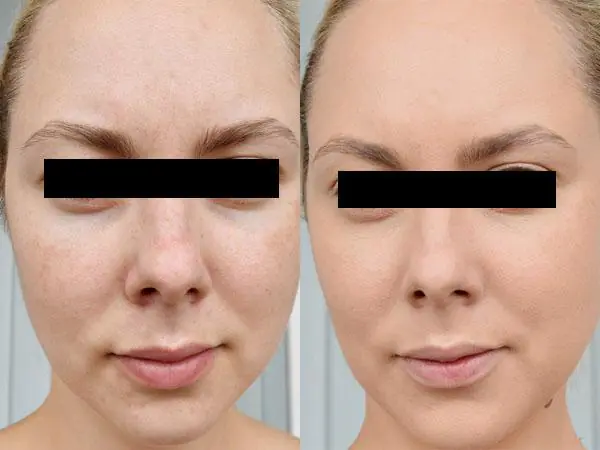
Healing period
After delicate peelings, the recovery period is very short, especially if a homemade exfoliating composition was applied to the skin. In just a few days, the face will look renewed, fresh, smoother. On the first day after peeling, you should not wash your face, touch the skin again, or apply decorative cosmetics. The doctor will tell you what products can be used to speed up the healing of the dermis. The specialist will also probably recommend special skincare products.
The first few weeks after peeling, you need to protect your skin from the sun: do not sunbathe, do not visit the solarium. Before each trip outside, you should use sunscreen cosmetics and regularly moisturize the treated areas with creams. In addition, during the rehabilitation period it is not advisable to go to the bathhouse, sauna or swimming pool.
Precautionary measures
Gentle peels usually do not cause serious side effects. After the procedure, slight redness and peeling are possible, which are considered normal and disappear within a few hours or a couple of days. The most serious consequence is pigmentation. It may occur due to improper rehabilitation or other reasons. Otherwise, gentle cleaning takes place with virtually no complications.
Attention! Sometimes the skin becomes very red and itchy - these are signs of an allergic reaction. Test the selected drug in advance.

When performing peeling in the salon and at home, some contraindications should be taken into account. As a rule, they are relevant for all skin types:
- pregnancy and lactation;
- increased sensitivity of the skin;
- damage to the epidermis - injuries, abrasions, cuts, burns;
- acute viral illnesses or colds accompanied by high fever;
- herpes in the active stage;
- individual intolerance to the components of the composition;
- exacerbation of chronic ailments;
- oncology, etc.
These prohibitions usually apply to salon peels. For home treatments, the list is less extensive.
Opinion of cosmetologists
Not all doctors call peeling a suitable procedure for dry facial skin, noting that after this the epidermis may experience an even greater moisture deficiency. That's why For women who decide to cleanse their face, it is important to consult with an experienced specialist. For example, this cosmetologist does not consider brossage to be a gentle technique.

It is necessary that the doctor not only select the optimal type of peeling taking into account your skin type, but also talk about all the nuances of the procedure, including possible contraindications and complications. The author who expressed this opinion is counseling a young mother who has recently completed her lactation period.

Patient reviews
Women often leave opinions about different types of peels for dry skin. For example, the author of this review praises drugs based on lactic acid.

Another girl believes that milk peels are good not only for salon use, but also for home use. The main thing is to choose the right tool.

There are reviews regarding specific products. For example, here we are talking about Gentle Peeling produced by Natura Siberica. A girl suffering from dry skin praises the drug, which turned out to be especially useful for her in the winter.

The author of this review has dry, sensitive skin with wrinkles, which reacts to changes in humidity in the room and on the street. On the advice of a cosmetologist, the girl did peeling with fruit acids, but was dissatisfied with it.

Dry and especially sensitive skin requires special care. Not every peel will suit her. Before the procedure, you must do a sensitivity test so as not to provoke an allergy.
You should start with the softest, most delicate means and procedures. Thanks to the right cleansing method, your skin will be smooth, even, and radiant. Only you will know that it is dry.
Useful videos
Peeling for dry skin.



